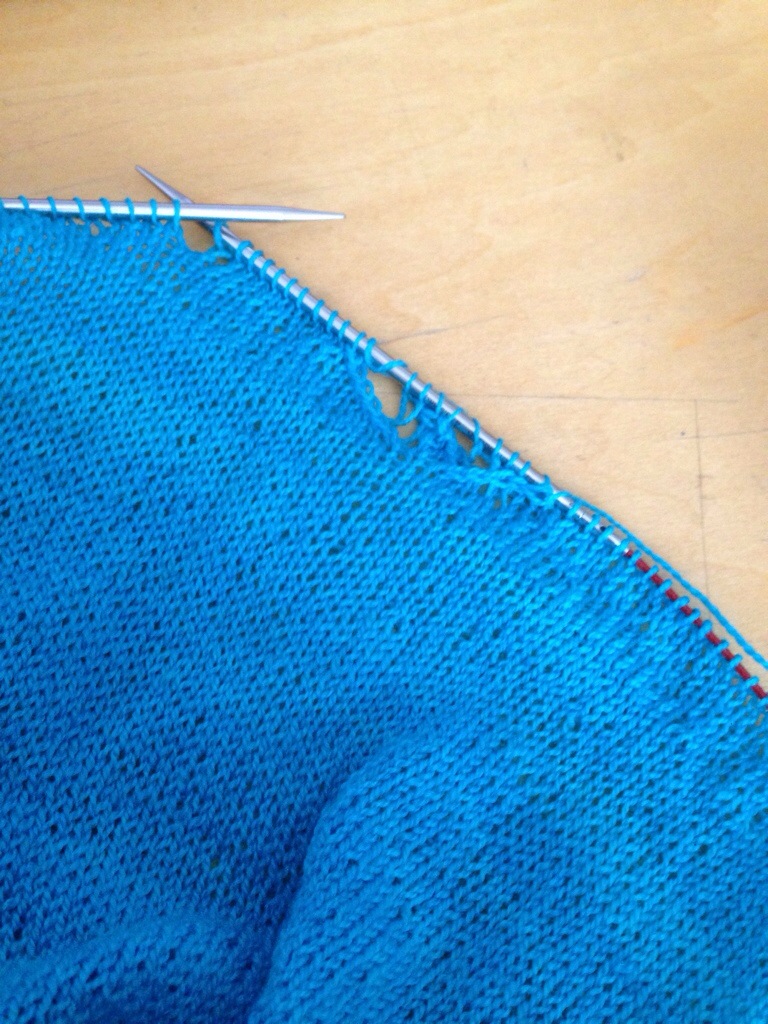The other day, I posted this photo to Instagram.

The color is off—this yarn is electric blue—but the important thing is that it pretty clearly shows the difference between a “blocked” fabric and an unblocked fabric (more on why I used quotations in a bit). The Anzula Wash My Lace that I’m using is 100% merino. Animal fibers are naturally crimped and tend to retain some of that crimp even after being processed and spun, even after being combed and carded (in general terms—some mills comb the fiber so that it is all nice and straight and you find a lot of that in braids sold to spinners). Anyway, crimpy hair + the process of spinning and plying can lead to your yarn being a bit wobbly when knitting with it.
Enter blocking. For the purpose of this discussion, I’m calling “blocking” the process of both washing and then pinning out a fabric to dry. In the case of this photo, I didn’t actually pin anything. I didn’t do my usual swatching for this project, because I knew that I was going to do this mid-project blocking. Since this was a laceweight project, worked in the round, over a lot of stitches, my usual process of knitting a 50 stitch swatch was not going to be sufficient to tell me about the fabric. So I went ahead and cast on for the tank with the plan to work a lot of fabric and then block it while still on the needles (technically still on the cables, since I’m using interchangeables). After letting the project soak in some water during the day, I came home and spread it out on one of my blocking mats. I tugged here and there to get a uniform fabric but didn’t pin anything.
The results speak for themselves. In the photo above, the part of the project that wasn’t knit at the time is crimped and wobbly. The bottom section is still a bit wobbly but much less so. And now I have a much more accurate gauge reading than I would have if I’d only worked a small gauge swatch.
I am the poster child for being impatient and just wanting to cast on right now and I’m not saying that’s a bad thing. Being excited about something? Super awesome excellent. But animal fibers can change dramatically after they get wet; even if the gauge doesn’t change, and I’ve had that happen, my stitches generally look neater and more professional after a good dousing. (Plant fibers generally don’t change at all in the blocking process, but getting the fiber wet and giving it a good tug will still help the stitches look nicer; I haven’t worked with enough synthetics to know if the stitches will change after washing but I expect a round in the washing machine would have the same effect as blocking natural fibers.)
Aaaaanyway…if you’re not already blocking your swatches and the finished projects, give it a whirl! Your finished knitting will lay smoother and look nicer, especially if you’re seaming a project. Blocking before seaming gives you a chance to pin out the pieces and make sure they’re all the same lengths which makes seaming so so so so so much easier.


I seriously did the exact same thing with my Bonny. I also added about seven inches to it because it was way too short for me. Now I’m debating if I really need to wear a tank top under it.